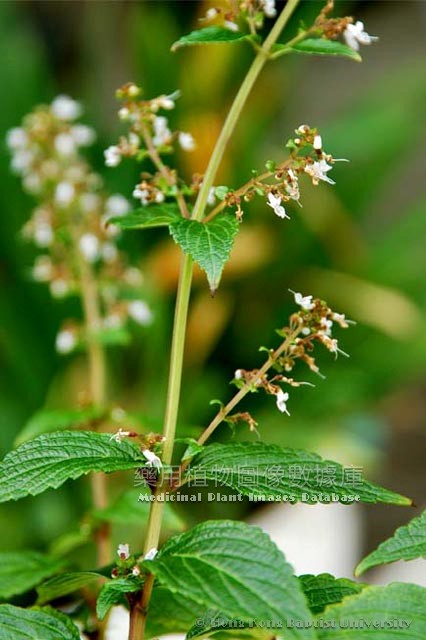|
Rabdosia serra (Mazim.) H. Hara

|
English Name |
Serrate Rabdosia, |
|
Latin name |
Rabdosia serra (Mazim.) H. Hara |
|
Family & Genus |
Lamiaceae, Rabdosia |
|
Description |
Perennial herb, 1.5-2m high. The rhizome lump-shaped, dense fibrous roots downward. Stems four edges, purplish, densely puberulent, upper much branched. Leaves opposite; petiole length 0.5-3.5cm; leaf blade ovate-orbicular or ovate-lanceolate, apex subacuminate, base cuneate, margin with incurved serrature, veins at both sides puberulent and with yellow glandular dots. Cymes composing sparse panicles, terminal, 10-20cm long, densely greyish pilose; bracteal leaf with short petiole, lanceolate or linear-lanceolate; bracts and bracteoles ovate to linear, pilose; calyx campanulate, ca. 1.5mm long, outside pilose and glandular dots, calyx teeth 5, long triangular, nearly equal in size, and nearly equal in length with calyx tube, calyx enlarged when fruiting, broadly campanulate; corolla purple, 5-6mm long, outside pubescent, above the base of corolla tube shallowly saccate, the upper lip 4 equally cleft, lower lip navicular; stamens 4, enclosed inside; style apex 2 lobed, outstretching. Nutlets broadly obovate, ca. 1.5mm long, apex with glandular dots and white beard. Flowering, fruiting: August to October. |
|
Distribution |
Always growing on hill-slopes, roadsides, paddy sides, stream sides, river banks and thickets. Distributed in Northeast China, Shanxi, Shaanxi, Gansu, Jiangsu, Anhui, Zhejiang, Jiangxi, Fujian, Taiwan, Henan, Hunan, Guangdong, Guangxi, Sichuan, Guizhou and etc. The medicinal materials are mainly produced in Northeast and East China, Shanxi, Henan, Shaanxi, Gansu, Sichuan, Guizhou and etc. |
|
Part Used |
Medical part: whole plant. Chinese name: Xihuangcao. |
|
Harvest & Processing |
Can be harvested 2-3 times per year, individually in the third month of planting, 75 d after the first harvest, and before winter, then sundried. Can be harvested dried herb about 3750kg per 11h㎡. |
|
Chemistry |
Leaves and stems contain diterpenes: rabdoserrin A, B, D, and excisanin A, 2α-hydroxyl-ursolic acid, ursolic acid, β-sitosterol and β-sitosterol glucoside. |
|
Pharmacology |
Having activity of anticancer, inhibitive on hela cells. |
|
Properties & Actions |
Bitter, cold.Clearing heat-toxin, disinhibiting dampness removing jaundice, dissipating stasis for detumescence. |
|
Indications & Usage |
Jaundice with damp-heat pathogen, cholecystitis, diarrhea, swelling sore, injury pains caused by falls.Oral administration: decocting, 15-30g. External application: appropriate amount, smashed for applying; or powdered for dusting. Use with caution in cases of deficient-cold in spleen and stomach. |
|
Examples |
1. Treat acute icteric hepatitis: serrate rabdosia, creeping dichondra, guangdong abrus, plantain 30g each, decoct in water and swallow.
2. Treat acute cholecystitis: serrate rabdosia 30g, rough gentian 9g, fructus gardeniae 12g, decoct in water and swallow. |
| Link to |
 Chinese Medicine Specimen Database Chinese Medicine Specimen Database
|
|

